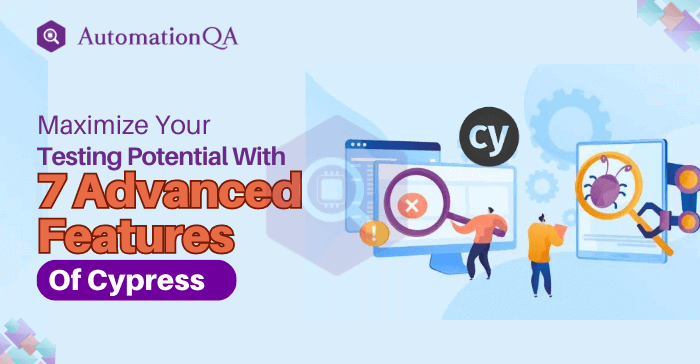
Are you looking for a way to optimize your software testing efforts while maximizing efficiency and accuracy? In today’s fast-paced digital landscape, delivering high-quality applications requires advanced testing techniques beyond the basics. That’s where Cypress, an open-sourced end-to-end testing framework, steps in. How well are you harnessing the full potential of the Cypress test?
Suppose you’re already familiar with Cypress or have been using it for your test automation needs. In that case, you might be intrigued to discover the top 7 advanced features that can elevate your testing game. And if you’re new to Cypress, you’re in for a treat.
In this blog post, we will unveil the hidden gems of Cypress—seven powerful features that can revolutionize the way you approach automated testing. From custom commands that simplify your test scripts to network stubbing and spying for comprehensive API testing, we’ll explore the tools and techniques that will take your Cypress test automation to the next level.
Let’s dive into the top 7 advanced features of Cypress that will transform the way you approach automated testing.
Advanced Features of Cypress Test
1. End-to-end (E2E) testing
E2E testing plays a crucial role in ensuring the seamless integration and functionality of various components within an application. Cypress 10 introduces a notable change in the E2E testing approach. Previously, QA/Test Engineers would primarily write E2E tests as part of the integrated component tests. However, with the latest version of Cypress, there has been a clear separation between E2E testing and component testing.
This change in Cypress test suites highlights the framework’s commitment to improving the efficiency and effectiveness of E2E testing. QA/Test Engineers can better structure their tests, streamline their testing processes, and ensure thorough coverage of end-to-end scenarios in their applications.
2. Cypress Config File
The updated format for the cypress.json configuration file includes cypress.config.js, cypress.config.ts, cypress.config.cjs, and cypress.config.mjs. Unlike before, Cypress no longer generates a default configuration file automatically. Just execute the “npm run cypress open” command to launch a browser-based interactive application.
This user-friendly tool, the Cypress Test Runner, will guide you effortlessly through the configuration process, whether setting up for End-to-End or Component testing. By embracing this revised approach, Cypress guarantees a seamless experience when configuring your test suite for optimal results.
3. Time Travel
Cypress’s time travel feature allows you to manipulate the timing of your application’s clock during test execution. It enables you to control and modify the behavior of timers, delays, and intervals within your application, allowing you to test time-based functionalities quickly.
With time travel, you can fast-forward or rewind time, wait for specific events or conditions, and validate the behavior of your application at different time points. This feature helps top Cypress consulting partners to ensure accurate testing of time-sensitive functionality without introducing arbitrary delays or timing issues.
4. Network Stubbing and Spying
One of the notable features of Cypress is its ability to stub network responses, granting users better control over their tests. This feature ensures regular tests by focusing solely on the application’s functionality without relying on excessive network calls.
Users can simulate the expected data by specifying the HTTP method and route matcher and utilizing a static JSON file to represent the desired API response. The accompanying code snippet demonstrates the power of Cypress as a test automation framework. It showcases how a GET request to “search/photos?query=mock” can be stubbed, ensuring that the expected mock data is returned for search results. The accompanying screenshot proves that the test remains reliable, even when the application’s API experiences problems or becomes unavailable.
5. Parallel Test Execution
Cypress allows running tests in parallel across multiple browser instances, dramatically reducing test execution time. With parallel test execution, you can split your test suite into numerous cases and execute them concurrently, maximizing resource utilization and speeding up feedback cycles. With its advanced features, Cypress seamlessly integrates test QA automation into your development workflow.
One such feature is Cypress’s ability to automatically manage test isolation and maintain a clean state for each parallel instance. This means that even when running tests in parallel, you can be confident that they won’t interfere with each other, ensuring accurate and reliable results.
6. Cypress Code Coverage
Code coverage tools scan your application’s source code and insert counters at various branches, statements, lines, and functions. These counters increment whenever your automated tests execute different sections of code. Once you finish the Cypress test, the tool logs the total number of hits vs. the total number of potential hits.
Integrating the code coverage plugin into your tests is a straightforward process. You can follow my comprehensive tutorial that walks you through the installation and configuration procedures. You can find the tutorial titled “Generating Code Coverage Report for Cypress” [hyperlink to the tutorial] for detailed instructions.
7. Visual Testing
Cypress testing provides built-in visual testing capabilities, allowing you to capture screenshots or record videos during test execution. This feature helps you visually validate the state of your application’s UI at different test stages. Visual testing can be precious for identifying visual regressions, ensuring consistent UI rendering across browsers and platforms, and verifying layout or style changes. Cypress test integrates with visual testing services like Percy or Applitools, enabling you to automate and manage visual test comparisons, baselines, and reporting for efficient visual regression testing.
Conclusion
By harnessing the advanced features of Cypress, you can supercharge your test automation efforts and achieve exceptional results. Whether creating custom commands for more readable and maintainable tests, leveraging fixtures for flexible test data management, or utilizing time travel to validate time-based functionalities, Cypress testing offers a rich set of capabilities that empower you to test with precision and confidence.
Moreover, the network stubbing and spying features allow you to simulate different API scenarios and ensure seamless data interactions. So, why settle for ordinary Cypress test automation when you can embrace the extraordinary?
